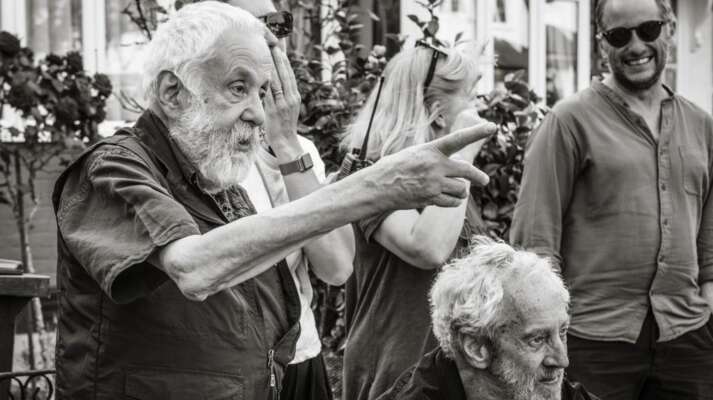ANTHROPOID | A Profound Act of Resistance
Sean Ellis’ ANTHROPOID recounts the extraordinary true story of how two commandos, Jan Kubiš (Jamie Dornan) and Jozef Gabčík (Cillian Murphy), parachuted into Czechoslovakia to assassinate the Nazi leader Reinhard Heydrich in 1942. Their mission, however, is not theirs alone. At every turn, members of the resistance risk their lives, as well as the lives of their friends and family, to help these men accomplish their mission. And afterwards, others selflessly assist them in hiding from the Nazi authorities. In Prague, Jan Zelenka-Hajský (Toby Jones) coordinates their mission with the local resistance teams. Two women––Marie Kovárníková (Charlotte Le Bon) and Lenka Fafková (Anna Geislerová)––start off as co-collaborators and end up as something much more. Across the Reich, in nearly every occupied nation, resistance fighters––either acting alone, in a cell, or as part of an armed militia––fought back in whatever way they could. Their heroic efforts, often lost to the pages of history, have inspired various filmmakers. We look at a few of the powerful films that capture the story of resistance.

Man Hunt | A Soldier Without a Nation
Fritz Lang’s 1941 thriller Man Hunt was adapted from Geoffrey Household’s 1939 best-selling novel, Rogue Male, about a sportsman who takes it upon himself to assassinate a fascist leader in central Europe. "Although the idea for Rogue Malegerminated from my intense dislike of Hitler, I did not actually name him in the book as things were a bit tricky at the time,” Household tells Radio Times. Before the war, it was not uncommon for publishers and film studios to fudge the details to comply with their government’s policy of appeasement. Alfred Hitchcock’s 1938 thriller The Lady Vanishes, for example, encouraged its audience to think “Nazis” even though it never actually specifies the country in which it takes place, let alone the name of the ruling party. When Rogue Male was acquired by Twentieth Century Fox to be adapted into Man Hunt, screenwriter Dudley Nichols felt it his duty to now name the leader as Hitler and the villains as the Gestapo. The film begins in July, 1939, when British hunter Captain Alan Thorndike (Walter Pidgeon) sneaks into the forest overlooking Hitler’s residence in Berghof to see what it would feel like “to sight a rifle at the bridge of Adolf Hitler’s nose.” When he does, guards catch him before he can get off a shot. Gestapo Major Quive-Smith (George Sanders) tortures him to get him to confess that he is a British agent sent to kill Hitler, a diplomatic bombshell that could destroy the fragile peace in Europe. When he refuses, the Nazis throw him off a cliff, hoping to kill him. But Thornhill miraculously survives and sneaks back into England, only to discover his impossible bind. The British government, bound by its fragile appeasement policies, cannot lift a finger to help him, even after Quive-Smith and his Nazi spies arrive in England to recapture or kill him. Left to the kindness of strangers, Thornhill is finally rescued by Jerry Stokes (Joan Bennett), a London workingwoman who risks her own life to help him out. The hero’s difficulty with government appeasement turned out to be a sticking point for the filmmakers as well. In reviewing the script, Joseph Breen of the Production Code Administration (PCA) flagged both what he called the film’s “Hate the Hun” tone and the “excessive brutality and gruesomeness” of the torture scenes, which, according to Breen, cast the Nazis as a “brutal and inhuman people.” Even after it was released, isolationist politicians during a Congressional hearing on Propaganda in Motion Pictures held upMan Huntas an example of Hollywood war mongering. Despite such political posturing, audiences loved the film. Its obvious lure was spelled out in the first line of Bosley Crowther’s New York Times review: “A great many folks in the world have toyed fondly with the dream of taking a pot shot at Hitler from some convenient blind.”
The Train | The Art of Fighting Back

During World War II, art curator Rose Valland risked her life funneling information to the French resistance about priceless pieces of art being plundered by the Nazis. Her remarkable experiences, collected in her 1961 memoir,
Le front de l’art, provided the inspiration for screenwriters Franklin Coen and Frank Davis. Using just three-and-half pages, which described how the French resistance thwarted Nazi plans to move Impressionist and Cubist paintings back to Germany by snarling up the train schedules, the writers created a full-on action war picture. In
The Train, yard manager Paul Labiche (Burt Lancaster), who at first is reluctant to risk men’s lives for old paintings, eventually leads an all-out assault to stop Col. Franz von Waldheim (Paul Scofield) from absconding with his country’s cultural legacy. First, he masterminds an ingenious plot that literally has the Germans going in circles by having his men dash ahead to change the names on train stations. Eventually, without the Germans knowing it, Labiche returns the train still carrying the masterpieces to Paris. His triumph, however, is cut short when Waldheim threatens vengeance. Arthur Penn, who envisioned the film as a moody mediation on art and war, was originally assigned to direct. But Lancaster, who was also a producer, pushed to replace him with the more action-oriented John Frankenheimer, who immediately trimmed the script and moved the production to France. Using actual locations, real train crashes, and having Lancaster do many of his own stunts, Frankenheimer put together a powerful and propulsive action picture that United Artists loved. So much so that they gave the production an additional half-million dollars to create a new stunt with a combat plane strafing the train. Frankenheimer’s push for realism, however, proved a bit too real when, as he recounts, "the Spitfire was roaring toward us at 300 miles an hour…I could see the pilot's face and he looked as terrified as I felt. He missed us by ten feet.” But such daredevil antics paid off on screen. “
The Train certainly does not lack for action and the kind of hair-trigger suspense that accumulates in the pursuit of a deeply perilous and uncertain intent,” exclaims
The New York Times. Despite such nail-biting drama,
The Train never loses sight of the cruel reality for resistance fighters, that every action of defiance bore an impossibly high price tag. As
The Dissolve’s Scott Tobias points out, “The film delves deeper into the reluctant heroism of everyday French citizens, when it would have been safer to mind their own business and wait for liberation.”
Army of Shadows | The Impossible Fight

In 1943, when Jean-Pierre Grumbach, a French resistance fighter stationed in London, read Joseph Kessel's recently published novel,
Army of Shadows, he was so taken by its unflinching portrait of the underground that he swore one day he would adapt it into a movie. Nearly 25 years later, Grumbach––who’d changed his name to Melville in honor of the American novelist––finally realized that youthful dream. In the novel’s preface, Kessel wrote, “Everything had to be accurate, and at the same time, nothing must be recognizable,” an aesthetic that in many ways describes Melville’s approach as well. Although many of the characters in his 1969
Army of Shadows (
L'armée des ombres) can be connected to actual personalities from the French Resistance, the film’s Sisyphean drama about the impossible fight faced by the French underground feels more allegorical than autobiographical. Beginning with the escape of Philippe Gerbier (Lino Ventura), the head of a resistance cell, the film chronicles his attempt to connect with the larger movement by traveling to London, only to be drawn back to France when members of his group are captured and tortured by the Nazis. In the end, simply maintaining the survival of his group, especially when any captured member might easily betray the rest, requires his full attention. Each of the cast delivers a virtuoso performance, perhaps none more so than Simone Signoret, who plays a patriotic housewife whose life is turned into an existential nightmare by the endless arrests, escapes, and betrayals she must negotiate. While Melville took more than a quarter of a century to realize his cinematic dream, the film itself would take another 36 years to find its audience. Being initially released right after France’s ’68 riots,
Army of Shadows’ patriotic ethos and positive portrayal of General Charles de Gaulle––considered in ’69 an enemy of the people––turned many critics against it, if simply as a matter of politics. It was not until 2006, when it finally received distribution in America, that it was heralded as a lost masterpiece. More than 20 major critics put the 1969
Army of Shadows on their top films of 2006. One of the critics proclaiming the film’s genius,
The Los Angeles Times’ Kenneth Turan succinctly explains its simple truth: “As someone who was part of the Resistance, Melville knew enough to neither melodramatically glorify nor cynically devalue the heroism he presents. This is people doing what needed to be done,
Army of Shadows says, this is the way it was.”
Black Book | A Long Story of Betrayal

After making his name with a series of flashy blockbusters in the 1990s, Paul Verhoeven returned home to the Netherlands to make his 2006
Black Book, a sexy and suspenseful story about a Dutch resistance fighter. Beginning on an Israeli kibbutz after the war, the film unfolds as a flashback in which Rachel Stein (Carice van Houten) recalls the serpentine political and personal path that brought her there. After seeing her family slaughtered by the SS during the war,
Stein reinvents herself as a blond chanteuse, Ellis de Vries, who entertains the German troops while secretly helping out the underground. After being asked by resistance leaders to seduce a SD commander, Ludwig Müntze (Sebastian Koch), in order to infiltrate and bug the Nazi headquarters, she unfortunately falls for her prey. Their impossible love is made even more difficult when they discover how many of their allies are traitors and how many resistance fighters are collaborators. While the film’s steamy mix of sex and sensationalism bear all the markings of Verhoeven’s Hollywood style, the story goes back to his earlier days as a Dutch filmmaker. Much of the research came from the work Verhoeven did with screenwriter Gerard Soeteman (who co-wrote
Black Book) for their 1977
Soldier of Orange, a dramatic adaptation of resistance fighter Erik Hazelhoff Roelfzema’s autobiography. Rachel Stein’s “character is based on an actual Dutch woman, Esmee van Eeghen, who was asked by the resistance to start an affair with a German officer,” Verhoeven explains to Indiewire. Going further back, Verhoeven’s interest in how his own people collaborated with the Nazis comes from his 1970 documentary on Anton Mussert, the Dutch fascist leader during the war. For Verhoeven, telling a story about the resistance meant also speaking out about Dutch complicity and anti-Semitism. "I wanted to show in an absorbing way what reality was like then. This is a postmodern look, not black and white, but in shades of gray," Verhoeven tells the
Jewish Journal. While some Dutch film critics took issue with his Hollywood approach, the Dutch people fully endorsed his warts-and-all history, giving it the highest box office for any domestic film that year. For some critics, Verhoeven’s brash style even worked in his favor by putting the period in a different light.
AV Club’s Noel Murray writes that Verhoeven created “a rollicking wartime movie-movie, replacing awards-bait clichés with a strong dose of two-fisted action, frank sexuality, and coal-black cynicism.”
Defiance | To Live On

With his 2008 drama
Defiance, Edward Zwick brought to the screen one of the most remarkable, if rarely told, stories of resistance from World War II. Adapted by Zwick and Clayton Frohman from Nechama Tec's 1993 book
Defiance: The Bielski Partisans, the film chronicles the history of the Bielski brothers, four Jewish siblings who evaded Nazi occupation by creating a secret encampment deep in the forest of an area now known as Belarus. When their parents are killed by a German Einsatzgruppe in 1941, the four brothers––Tuvia (Daniel Craig), Zus (Liev Schreiber), Asael (Jamie Bell) and Aron (George MacKay)––disappear into the Naliboki forest where they encounter and help organize other Jewish refugees into a nomadic village. Setting up camp for a short period before moving on to avoid detection, the Bielski-founded community survived for years, swelling to over 1,200 members at one time before disbanding after the war. Zwick, who acquired the rights to the book before it was even published, felt the story provided a powerful counter narrative to that of Jewish helplessness. “I think there’s a false impression that Jews only went willingly and that the idea was that there was no impulse to resist when in fact every time there was an opportunity it was taken,” Zwick tells History.net. “This is one such time in which it was very successful.” After its release, the film faced contrary charges of both sugarcoating history, including ignoring possible charges of war crimes, and painting too bleak a picture. In defending the film, Zwick acknowledges, "the Bielskis weren't saints. They were flawed heroes, which is what makes them so real and so fascinating.” Indeed, for many critics, the Bielskis’ story, like that of many resistance fighters, must be understood in the context of the unbearable reality in which they lived. For
The Seattle Times’ Moira MacDonald, “
the film celebrates and memorializes the survival of something unthinkable, and a group of people for whom defiance meant, at heart, that they would push against the growing darkness and carry on.”







